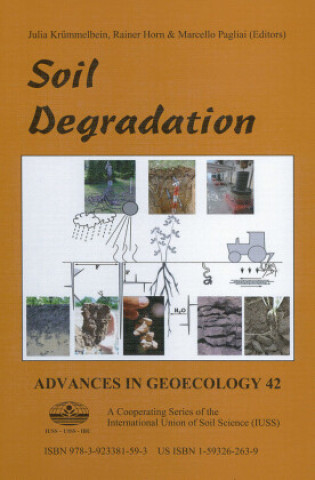
Kód: 15196224
Soil Degradation
Autor Julia Krümmelbein, Rainer Horn, Marcello Pagliai
Soils are regularly exposed to different kinds of external loads, which can be described as static or dynamic and are always variable in loading time and magnitude. How far these external forces and soil management strategies coin ... celý popis
- Jazyk:
 Angličtina
Angličtina - Vazba: Pevná
- Počet stran: 339
Nakladatelství: Schweizerbart'sche Verlagsbuchhandlung, 2013
- Více informací o knize

3909 Kč
Dostupnost:
50 % šance Máme informaci, že by titul mohl být dostupný. Na základě vaší objednávky se ho pokusíme do 6 týdnů zajistit.
Máme informaci, že by titul mohl být dostupný. Na základě vaší objednávky se ho pokusíme do 6 týdnů zajistit.Prohledáme celý svět
Mohlo by se vám také líbit
Darujte tuto knihu ještě dnes
- Objednejte knihu a zvolte Zaslat jako dárek.
- Obratem obdržíte darovací poukaz na knihu, který můžete ihned předat obdarovanému.
- Knihu zašleme na adresu obdarovaného, o nic se nestaráte.
Informovat o naskladnění knihy
Zadejte do formuláře e-mailovou adresu a jakmile knihu naskladníme, zašleme vám o tom zprávu. Pohlídáme vše za vás.
Více informací o knize Soil Degradation
Nákupem získáte 391 bodů
 Anotace knihy
Anotace knihy
Soils are regularly exposed to different kinds of external loads, which can be described as static or dynamic and are always variable in loading time and magnitude. How far these external forces and soil management strategies coincide with the approach of sustainability of soils and their functions in a changing world with an intensely growing population is often discussed controversially. The most recent flooding events in Germany, Poland, Austria, Czech Republic, etc. and the catastrophic landslides in Italy, etc., also visualize the enormous effects and threats which must be linked to the manmade soil degradation due to non-site adjusted management approaches in combination with climate change-induced intensified rainstorm events etc. This idea becomes even more relevant with increasing intensity of soil cultivation-induced changes of mechanical, hydraulic and physicochemical soil processes and functions. The result of such processes must be defined as a degraded system, which certainly requires a better and more process based understanding of the dominant processes under the aspect of requested crop yield increase, better filtering and buffering for clean drinking water production as well as also concerning a less intense climate gas emission to the atmosphere (global change effect). In the following, various aspects of mainly mechanical soil degradation will be described in the book elucidating the various scale effects as well as the consequences also for soil erosion and its quantification. Eight contributions deal with scale dependent processes of soil degradation from micro- to macroscale and they also describe the interactions between soil particles and chemistry on soil strength. The rheological approach including the differentiation between various chemical properties gives a fascinating insight into the soil processes and properties. On such a basis also the following up processes of the aggregate level can be better understood and it certainly also helps to link results with a more complete concept. The basis for mechanical processes is still the effective stress equation which in itself can be subdivided in the various scale effects. Finally both a more complete picture of the strengthening but also of the degradation processes can be derived and countermeasures can be developed. These countermeasures also include natural soil regeneration or amelioration approaches based on the quantified internal soil strength and the information about the actual mechanical sensitivity of the soil being threatened by soil compaction and deformation. The first paper of Baumgarten and Horn deals with the assessment of soil degradation by using a scale-spanning soil mechanical approach followed by Khaydapova et al. who study with the impact of Anthropogenic Load on rheological properties of typical Chernozems. The effect of aggregation on soil strength and the risk of soil degradation for soils derived from volcanic ash is described by Fuentes et al., while Stumpf et al. define aggregate properties of a constructed soil in Southern Brazil. How far organic carbon affects the mechanical strength and biological properties of single aggregates is defined by Mordhorst et al. Zink et al. define an approach to quantify subsoil compaction on cable construction sites while Levy and Mamedov deal with the bulk soil susceptibility to deformation in different agricultural management practices and discuss the applicability of water retention curve patterns. In their contribution Weisskopf et al. describe interesting results concerning evolution of structural properties of an arable soil after compaction under different regeneration pathways. Krummel-bein and Horn finally introduce the circular characteristics of soil structure formation and degradation and following implications. The consequences of non-site adjusted soil management on soil erosion are the topics of two contributions by Pellegrini et al. about the assess
 Parametry knihy
Parametry knihy
3909 Kč
- Plný název: Soil Degradation
- Autor: Julia Krümmelbein, Rainer Horn, Marcello Pagliai
- Jazyk:
 Angličtina
Angličtina - Vazba: Pevná
- Počet stran: 339
- EAN: 9783510653805
- ID: 15196224
- Nakladatelství: Schweizerbart'sche Verlagsbuchhandlung
- Hmotnost: 810 g
- Rozměry: 240 × 170 × 24 mm
- Rok vydání: 2013
Oblíbené z jiného soudku
-

Dune
262 Kč -

Haunting Adeline
617 Kč -

Berserk Deluxe Volume 2
1050 Kč -

White Nights
90 Kč -

Powerless
276 Kč -

Atomic Habits
340 Kč -

Dune Messiah
178 Kč -

Berserk Deluxe Volume 3
1138 Kč -

One Day
276 Kč -

Berserk Deluxe Volume 1
1033 Kč -

Iron Flame
353 Kč -

Surrounded by Idiots
256 Kč -

Harry Potter and the Prisoner of Azkaban (Minalima Edition)
688 Kč -

Gravity Falls Journal 3
440 Kč -

Heaven Official's Blessing: Tian Guan Ci Fu (Novel) Vol. 1
426 Kč -

The Creative Act
586 Kč -

Dune
214 Kč -

Hunting Adeline
633 Kč -

A Little Life
276 Kč -

Children of Dune
174 Kč -

Heaven Official's Blessing: Tian Guan Ci Fu (Novel) Vol. 2
441 Kč -

Bungo Stray Dogs, Vol. 8 (light novel)
426 Kč -

Percy Jackson and the Olympians 5 Book Paperback Boxed Set
953 Kč -

Solo Leveling, Vol. 1
461 Kč -

The Prisoner's Throne
238 Kč -

Court of Thorns and Roses
254 Kč -

Cry Baby Coloring Book
256 Kč -

Fourth Wing
351 Kč -

Icebreaker
200 Kč -

Berserk Deluxe Volume 6
1086 Kč -

Avatar, the Last Airbender: The Kyoshi Novels (Box Set)
676 Kč -

The 48 Laws of Power
530 Kč -

House of Leaves
405 Kč -

Twisted Lies
276 Kč -

Dune Messiah
220 Kč -

No Longer Human
340 Kč -

48 Laws Of Power
471 Kč -

Twisted Games
276 Kč -

Caraval Paperback Boxed Set
906 Kč -

Solo Leveling, Vol. 2
448 Kč -

Open Circuits
861 Kč -

Berserk Deluxe Volume 5
1115 Kč -

Heaven Official's Blessing: Tian Guan Ci Fu (Novel) Vol. 3
410 Kč -

Berserk Deluxe Volume 4
1165 Kč -

Court of Mist and Fury
221 Kč -

SOLO LEVELING V08
450 Kč -

English File Upper Intermediate Multipack A (4th)
495 Kč -

CHAINSAW MAN V14
250 Kč -

Before the Coffee Gets Cold
191 Kč
Osobní odběr Praha, Brno a 12903 dalších
Copyright ©2008-24 nejlevnejsi-knihy.cz Všechna práva vyhrazenaSoukromíCookies



 Vrácení do měsíce
Vrácení do měsíce 571 999 099 (8-15.30h)
571 999 099 (8-15.30h)